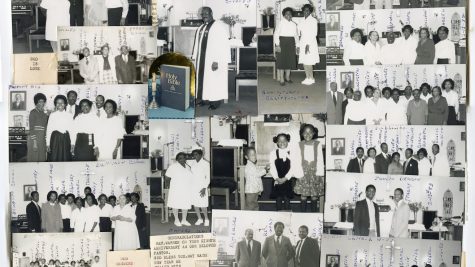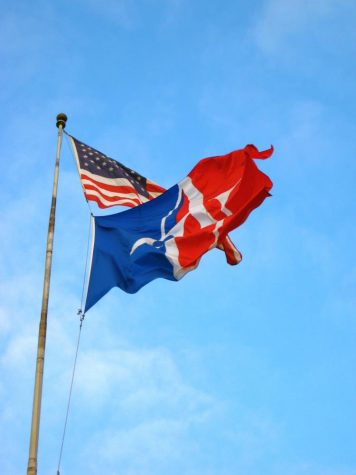Opinion || Policing with force: The problem with police brutality
Tamir Rice, a 12-year-old African American boy, was playing outside a recreation center with a toy gun. Two police officers arrived at the scene after receiving a 911 call about suspicious activity. Within two seconds of exiting the car, police officer Timothy Loehmann shot Rice in the abdomen. He died the next day.
According to the Associated Press, attorneys have filed claims for “excessive force, negligence, infliction of emotional distress on his sister and mother, violation of due process for the parents, and failure by the responding officers to provide first aid to the boy immediately after the shooting.”
The initial 911 call said that the weapon was probably fake and the suspect was most likely a juvenile, but the information was not relayed to the responding officers. The combination of miscommunication and force ultimately led to the death of a 12-year-old boy.
Another example of police brutality is Jesse Hagopian, who was pepper sprayed by a police officer in Seattle after speaking in a Black Lives Matter rally on Martin Luther King day. Hagopian was only walking by, talking on the phone, when he was pepper sprayed while other police officers simply watched. According to an article from RT “Efforts to Curb Police Brutality ‘Met With More Force’ –Pepper-Sprayed Teacher,” Hagopain is suing city authorities and police for $500,000 in damages.
How other countries address policing:
Assuming the police cannot be disarmed––as a result of both their image (i.e. their public perception) and the power of lobbying groups, such as the NRA––looking at how we can limit the availability of guns could result in lower deaths by police, as evidenced by both the UK and Japan.
Japan limits the accessibility to guns for police officers by making them go through a rigorous training program before they are armed. In Britain, most officers do not carry a weapon unless they are specialist firearm officers. According to an article from The Economist “Armed Forces,” Britain citizens are 100 times less likely to be shot by a police officer than in America.
In Britain, police officers fired only three times in 2013, and no one was fatally shot according The Economist. Because of the decreased use of firearms in the police force, Britain has far less fatality shootings than the U.S. However, Britain does struggle with Taser usage by police officers. According to the UK government website, Tasers were used more than 10,000 times in 2013 in England and Wales. Even then, according to the “Excessive Use of Force” report by Amnesty International, 540 and people died in the U.S. between 2001 and 2013 because of Tasers. That’s about seven times more than the annual death rates of England and Wales due to Tasers. Our problem of police brutality is not limited to gun violence, but rather our tendency to resort to violence.
The problem of race and racial profiling:
Still, this doesn’t address underlying problems surrounding implicit and institutional racism. A study looked at the depiction of suspects in police training videos, and found that the majority of the suspects were people of color. Unequal policing of people of color in comparison to whites, has led to 1 of 3 black men having some relationship with the justice system—on probation, in jail, or on parole. It’s an unequal and unjust system; especially since FBI reports consistently show that black and white Americans commit crimes at the same rate.
However, the race issue within the justice system does not end here. Inequalities with the death penalty, length of sentencing, stop and frisk laws, determinate sentencing, and recidivism rates point to a larger institutional framework of police brutality. Until that can be addressed, however, there needs to be some changes.
The phenomenon of police brutality and violence is large, and implying that it can be fixed by reducing the number of weapons available to the police force is a band-aid solution. Yet, it is still one that needs to be considered, especially since addressing deep-rooted racism and institutional issues will take time.
According to the FBI Uniform Crime Report, there were 461 justifiable homicides by police officers in their line of duty in 2013. This number is not entirely representative of all the deaths because many law enforcement agencies do not report to the FBI databases. The real number is probably much higher. USA Today analyzed the FBI’s statistics and found that 96 deaths were from a white officer killing a black man.
A final note on police brutality
By requiring all police departments to report deadly use of force to the FBI, perhaps we can see the true number of deaths that occur in America during the line of duty. Until we have accurately and timely reported statistics, we cannot accurately gauge the American experience with police brutality. But from the statistics we have, we know it exists.
This is not to say that all police officers use excessive force. There are a lot of highly stressful situations that come with being a police officer. Some officers act honorably and do the best they can to protect citizens from harm. However, in a society that is barraged by institutional and deeply rooted racism and beliefs on how the justice system is supposed to act, we need to address police brutality more readily.
There needs to be stricter training for police officers when they are armed in their line of duty or more accountability for police officers who use lethal force when it is unnecessary. A twelve-year-old boy should not be shot for playing with a fake gun, nor should a history teacher be pepper sprayed after speaking in a Black Lives Matter speech when he was not starting a confrontation.











